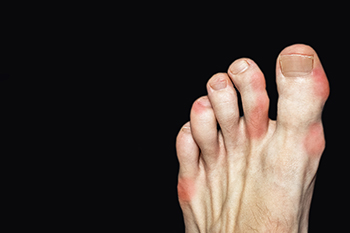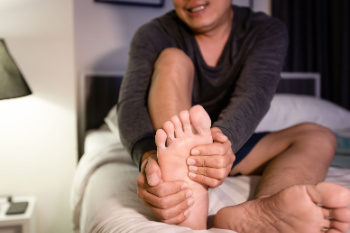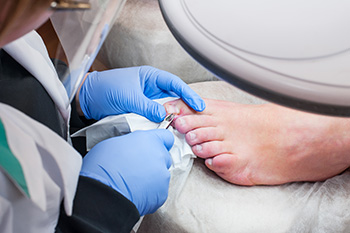
Wilmington (937) 382-2347
Fax
(513) 932-1606

Wilmington (937) 382-2347
Fax
(513) 932-1606
Overtraining and overusing the feet are the main causes of common running injuries. A number of these common injuries are caused by overrunning. Runner’s knee is a condition that is characterized by the back of the kneecap beginning to wear away and cause pain in the knee. This frequently occurs due to either a decrease in strength in the quadriceps muscles or ill-fitting shoes that are lacking in proper support for the inside of the forefoot. Strengthening exercises focusing on the quad muscle and sports orthotics are the usual treatments for those suffering from runner’s knee. Prevention of the condition lies in a focus on hip strengthening and quad-strengthening to keep the kneecap aligned. To help learn the best exercise to heal runner’s knee, one can also undergo physical therapy.
One common injury, called iliotibial band syndrome, is often caused by overtraining. This condition occurs when the iliotibial band gets irritated, creating pain and discomfort in the outside knee area. Plantar fasciitis, another common running injury, also occurs as a result of inflammation and irritation. Plantar fasciitis is an inflammation and irritation of the bone in the foot. A large amount of pain is often experienced due to plantar fasciitis. The condition can be caused by a high arch, improper footwear, tight muscles, or flat feet. It can best be avoided by stretching and wearing appropriate footwear that supports the foot.
Another common injury for runners is stress fractures. These injuries occur due to running style, overtraining, or a lack of calcium. Stress fractures most often occur in several locations in runners, including the inner bone of the leg, the thighbone, the bone at the base of the spine and the bones of the toes. Stress fractures are best prevented by wearing proper footwear and by running on flat and hard surfaces; this will absorb some of the shock created during running.
Aside from overtraining, other causes of common running injuries include ill-fitting footwear, a lack of flexibility and strength, and irregular biomechanics. The best way to avoid running injuries is to prevent them from even occurring. Both iliotibial band syndrome and stress fractures are preventable. The first step that should be taken to prevent running injuries is to only wear footwear that fits properly and that is appropriate for whatever activity you are doing. Running shoes are the only protective gear available to runners that can safeguard them from sustaining injuries. Choosing the right pair of shoes is therefore extremely important. While running shoes are an important factor, it is also important to consider other facets of your running routine such as training schedules, flexibility, and strengthening. These elements should be considered and altered according to your running needs to best maximize your run and minimize the possibility of injury. Careful stretching before and after a run should also be considered to help prevent running injuries. Stretching muscles enables greater flexibility and a lesser chance of sustaining injury.
 Running is often considered a contact sport due to the repeated impact of the feet striking the ground. To avoid injuries while running, it is important to follow some key tips. Begin with a proper warm-up to prepare your muscles and joints for the activity ahead. Running at an easy pace most of the time allows your body to adapt to the stresses of running, reducing the risk of overuse injuries. Gradually increasing your running intensity and distance helps to build endurance and strength safely. Incorporate strength training exercises to enhance muscle stability and support your joints. Pay attention to your running form, maintaining an upright posture and a mid-foot strike to distribute impact forces evenly. Wearing appropriate, well-fitted running shoes is essential to provide the necessary support and cushioning. Lastly, listen to your body, and rest if you feel pain or discomfort. If you are a runner, to get the most out of your sport, it is suggested that you seek personalized advice and injury prevention strategies from a podiatrist.
Running is often considered a contact sport due to the repeated impact of the feet striking the ground. To avoid injuries while running, it is important to follow some key tips. Begin with a proper warm-up to prepare your muscles and joints for the activity ahead. Running at an easy pace most of the time allows your body to adapt to the stresses of running, reducing the risk of overuse injuries. Gradually increasing your running intensity and distance helps to build endurance and strength safely. Incorporate strength training exercises to enhance muscle stability and support your joints. Pay attention to your running form, maintaining an upright posture and a mid-foot strike to distribute impact forces evenly. Wearing appropriate, well-fitted running shoes is essential to provide the necessary support and cushioning. Lastly, listen to your body, and rest if you feel pain or discomfort. If you are a runner, to get the most out of your sport, it is suggested that you seek personalized advice and injury prevention strategies from a podiatrist.
All runners should take extra precaution when trying to avoid injury. If you have any concerns about your feet, contact Dr. Gerald Perelman of Ohio. Our doctor will treat your foot and ankle needs.
How to Prevent Running Injuries
There are a lot of mistakes a runner can make prior to a workout that can induce injury. A lot of athletes tend to overstretch before running, instead of saving those workouts for a post-run routine. Deep lunges and hand-to-toe hamstring pulls should be performed after a workout instead of during a warmup. Another common mistake is jumping into an intense routine before your body is physically prepared for it. You should try to ease your way into long-distance running instead of forcing yourself to rush into it.
More Tips for Preventing Injury
If you have any questions, please feel free to contact our office located in Wilmington, OH . We offer the newest diagnostic and treatment technologies for all your foot care needs.
Gout is a form of arthritis that is caused by a buildup of uric acid crystals in the joints. This considered to be one of the most frequently recorded medical illnesses throughout history. Gout occurrences in the US have risen within the past twenty years and the condition now affects 8.3 million people which is 4% of all Americans. Researchers have found that gout affects men more than women and African-American men more than white men.
Symptoms of gout are warmth, swelling, discoloration, and tenderness in the affected joint area. The small joint on the big toe is the most common place for a gout attack to occur.
People who are obese, gain weight excessively, drink alcohol heavily, have high blood pressure, or have abnormal kidney function are more likely to develop gout. Furthermore, certain drugs and diseases are likely to increase levels of uric acid in the joints which eventually leads to gout. You are also more likely to develop gout if you eat a lot of meat and fish.
Many who experience gout attacks will experience repeated attacks over the years. Some people who have gout symptoms, may never have them again, but others may experience them several times a year. If you have gout symptoms throughout the year, you may have recurrent gout. Those who have gout should also be careful about their urate crystals collecting in their urinary tract, because this may lead to kidney stones.
Diagnosis for gout is done by checking the level of uric acid in the joints and blood. Your podiatrist may also prescribe medicine to reduce uric acid buildup in the blood, which will help prevent any gout attacks.
To treat gout, your podiatrist may also prescribe you Anti-inflammatory medication (NSAIDs) which will relieve the pain and swelling of a gout episode and it can also shorten a gout attack. Maintaining a healthy diet is also a proven method to prevent gout attacks.
 Gout is a type of arthritis that causes sudden, severe attacks of pain, redness, and tenderness in joints, often affecting the feet. It occurs when urate crystals accumulate in the joints, causing inflammation and intense pain. These crystals form when there are high levels of uric acid in the blood. The body produces uric acid when it breaks down purines, substances found naturally in the body, and certain foods. Gout can affect anyone, but it is more common in men, postmenopausal women, and individuals with kidney disease or a family history of gout. In the feet, gout typically impacts the big toe, but it can also affect other parts like the ankles and heels. The pain can be excruciating, described as a burning or stabbing sensation, often waking individuals from sleep. Swelling, redness, and warmth in the affected area are common symptoms. To manage gout, lifestyle changes such as diet modification, weight loss, and avoiding alcohol are recommended. Medications to reduce uric acid levels and inflammation may also be prescribed. If you experience severe foot pain due to gout, it is suggested that you schedule an appointment with a podiatrist for targeted treatment and management strategies.
Gout is a type of arthritis that causes sudden, severe attacks of pain, redness, and tenderness in joints, often affecting the feet. It occurs when urate crystals accumulate in the joints, causing inflammation and intense pain. These crystals form when there are high levels of uric acid in the blood. The body produces uric acid when it breaks down purines, substances found naturally in the body, and certain foods. Gout can affect anyone, but it is more common in men, postmenopausal women, and individuals with kidney disease or a family history of gout. In the feet, gout typically impacts the big toe, but it can also affect other parts like the ankles and heels. The pain can be excruciating, described as a burning or stabbing sensation, often waking individuals from sleep. Swelling, redness, and warmth in the affected area are common symptoms. To manage gout, lifestyle changes such as diet modification, weight loss, and avoiding alcohol are recommended. Medications to reduce uric acid levels and inflammation may also be prescribed. If you experience severe foot pain due to gout, it is suggested that you schedule an appointment with a podiatrist for targeted treatment and management strategies.
Gout is a painful condition that can be treated. If you are seeking treatment, contact Dr. Gerald Perelman from Ohio. Our doctor will treat your foot and ankle needs.
What Is Gout?
Gout is a form of arthritis that is characterized by sudden, severe attacks of pain, redness, and tenderness in the joints. The condition usually affects the joint at the base of the big toe. A gout attack can occur at any random time, such as the middle of the night while you are asleep.
Symptoms
Risk Factors
Prior to visiting your podiatrist to receive treatment for gout, there are a few things you should do beforehand. If you have gout you should write down your symptoms--including when they started and how often you experience them, important medical information you may have, and any questions you may have. Writing down these three things will help your podiatrist in assessing your specific situation so that he or she may provide the best route of treatment for you.
If you have any questions, please feel free to contact our office located in Wilmington, OH . We offer the newest diagnostic and treatment technologies for all your foot care needs.
Plantar fasciitis is one of the most common causes of heel pain. The plantar fascia is the thick band of tissue that connects the heel bone to the toes. When this band of connective tissue becomes inflamed, plantar fasciitis occurs. Fortunately, this condition is treatable.
There are several factors that may put you at a greater risk for developing plantar fasciitis. One of the biggest factors is age; plantar fasciitis is common in those between the ages of 40 to 60. People who have jobs that require them to be on their feet are also likely to develop plantar fasciitis. This includes factory workers, teachers, and others who spend a large portion of their day walking around on hard surfaces. Another risk factor is obesity because excess weight can result in extra stress being placed on the plantar fascia.
People with plantar fasciitis often experience a stabbing pain in the heel area. This pain is usually at its worst in the morning, but can also be triggered by periods of standing or sitting. Plantar fasciitis may make it hard to run and walk. It may also make the foot feel stiff and sensitive, which consequently makes walking barefoot difficult.
Treatment for plantar fasciitis depends on the severity of the specific case of the condition. Ice massage applications may be used to reduce pain and inflammation. Physical therapy is often used to treat plantar fasciitis, and this may include stretching exercises. Another treatment option is anti-inflammatory medication, such as ibuprofen.
If you suspect that you have plantar fasciitis, meet with your podiatrist immediately. If left untreated, symptoms may lead to tearing and overstretching of the plantar fascia. The solution is early detection and treatment. Be sure to speak with your podiatrist if you are experiencing heel pain.
 Plantar fasciitis significantly impacts quality of life, primarily due to persistent heel pain. This condition involves inflammation of the plantar fascia, a thick band of tissue running along the bottom of the foot, often resulting in stabbing pain, particularly during the first steps in the morning or after periods of inactivity. The pain can range from a dull ache to sharp discomfort, making walking, standing, and engaging in daily activities challenging. Symptoms can include heel pain, stiffness, and swelling. Common causes are overuse, wearing improper footwear, obesity, and excessive standing or walking on hard surfaces. Relief options include rest, stretching exercises, proper footwear, and orthotic devices to provide arch support. In severe cases, medical interventions such as corticosteroid injections or surgery might be necessary. If you suffer from plantar fasciitis, it is suggested that you schedule an appointment with a podiatrist to manage it and prevent further complications.
Plantar fasciitis significantly impacts quality of life, primarily due to persistent heel pain. This condition involves inflammation of the plantar fascia, a thick band of tissue running along the bottom of the foot, often resulting in stabbing pain, particularly during the first steps in the morning or after periods of inactivity. The pain can range from a dull ache to sharp discomfort, making walking, standing, and engaging in daily activities challenging. Symptoms can include heel pain, stiffness, and swelling. Common causes are overuse, wearing improper footwear, obesity, and excessive standing or walking on hard surfaces. Relief options include rest, stretching exercises, proper footwear, and orthotic devices to provide arch support. In severe cases, medical interventions such as corticosteroid injections or surgery might be necessary. If you suffer from plantar fasciitis, it is suggested that you schedule an appointment with a podiatrist to manage it and prevent further complications.
Plantar fasciitis is a common foot condition that is often caused by a strain injury. If you are experiencing heel pain or symptoms of plantar fasciitis, contact Dr. Gerald Perelman from Ohio. Our doctor can provide the care you need to keep you pain-free and on your feet.
What Is Plantar Fasciitis?
Plantar fasciitis is one of the most common causes of heel pain. The plantar fascia is a ligament that connects your heel to the front of your foot. When this ligament becomes inflamed, plantar fasciitis is the result. If you have plantar fasciitis you will have a stabbing pain that usually occurs with your first steps in the morning. As the day progresses and you walk around more, this pain will start to disappear, but it will return after long periods of standing or sitting.
What Causes Plantar Fasciitis?
There are some risk factors that may make you more likely to develop plantar fasciitis compared to others. The condition most commonly affects adults between the ages of 40 and 60. It also tends to affect people who are obese because the extra pounds result in extra stress being placed on the plantar fascia.
Prevention
There are a variety of treatment options available for plantar fasciitis along with the pain that accompanies it. Additionally, physical therapy is a very important component in the treatment process. It is important that you meet with your podiatrist to determine which treatment option is best for you.
If you have any questions, please feel free to contact our office located in Wilmington, OH . We offer the newest diagnostic and treatment technologies for all your foot care needs.
Ingrown toenails (onychocryptosis) are a common foot ailment and it is very unpleasant to experience. The condition is caused by an increase in pressure from the ingrowth of the nail edge into the skin of the toe. Ingrown toenails commonly cause pain in those who experience them. In some cases, the skin surrounding the ingrown toenail may break which may lead bacteria to enter through and cause an infection. Common symptoms of this ailment include pain, redness, swelling, and warmth around the toe.
An imbalance between the size of the nail and the enlargement of the nail skin edge causes ingrown toenails. This condition is often caused by improperly trimming the toenails. If you are trying you cut your nails, you should always try to trim straight across instead of in a rounded shape. Ingrown toenails can also be an inherited condition and they may also be caused by improper shoe fitting.
Another common cause of the condition is wearing shoes that are either too small or too large. Other causes include poor foot hygiene, obesity, diabetes, arthritis, edema, and fungal infections. There are many risk factors that may make a person more likely to develop an ingrown toenail. Athletes who play “stop and start” sports such as tennis, soccer, and basketball are most likely to have ingrown toenails.
People who have diabetes, a compromised immune system, or poor circulation should immediately seek care from a podiatrist if they have an ingrown toenail. It is also recommended to seek professional assistance if at-home remedies are not successful within a week or if there is persistent pain.
 Ingrown toenails occur when the nail grows into the surrounding skin, which causes pain and has a potential for infection. Podiatrists, or foot doctors, can treat ingrown toenails through a variety of procedures depending on the severity. For less severe cases, a podiatrist may carefully trim the ingrown portion of the nail and instruct the patient on proper nail care techniques to prevent recurrence. If the ingrown toenail is more problematic or keeps coming back, a podiatrist might perform a partial nail avulsion. This involves numbing the toe and then removing the ingrown section of the nail. In some cases, a podiatrist may also apply a chemical called phenol to the affected nail root to prevent the problematic portion of the nail from growing back. These procedures are generally quick, done with minimal discomfort, and allow patients to return to daily activities fairly quickly. If you are suffering with an ingrown toenail, it is suggested that you consult a podiatrist for treatment and to prevent the ingrown toenail from returning.
Ingrown toenails occur when the nail grows into the surrounding skin, which causes pain and has a potential for infection. Podiatrists, or foot doctors, can treat ingrown toenails through a variety of procedures depending on the severity. For less severe cases, a podiatrist may carefully trim the ingrown portion of the nail and instruct the patient on proper nail care techniques to prevent recurrence. If the ingrown toenail is more problematic or keeps coming back, a podiatrist might perform a partial nail avulsion. This involves numbing the toe and then removing the ingrown section of the nail. In some cases, a podiatrist may also apply a chemical called phenol to the affected nail root to prevent the problematic portion of the nail from growing back. These procedures are generally quick, done with minimal discomfort, and allow patients to return to daily activities fairly quickly. If you are suffering with an ingrown toenail, it is suggested that you consult a podiatrist for treatment and to prevent the ingrown toenail from returning.
Ingrown toenails may initially present themselves as a minor discomfort, but they may progress into an infection in the skin without proper treatment. For more information about ingrown toenails, contact Dr. Gerald Perelman of Ohio. Our doctor can provide the care you need to keep you pain-free and on your feet.
Ingrown Toenails
Ingrown toenails are caused when the corner or side of a toenail grows into the soft flesh surrounding it. They often result in redness, swelling, pain, and in some cases, infection. This condition typically affects the big toe and may recur if it is not treated properly.
Causes
You are more likely to develop an ingrown toenail if you are obese, have diabetes, arthritis, or have any fungal infection in your nails. Additionally, people who have foot or toe deformities are at a higher risk of developing an ingrown toenail.
Symptoms
Some symptoms of ingrown toenails are redness, swelling, and pain. In rare cases, there may be a yellowish drainage coming from the nail.
Treatment
Ignoring an ingrown toenail can have serious complications. Infections of the nail border can progress to a deeper soft-tissue infection, which can then turn into a bone infection. You should always speak with your podiatrist if you suspect you have an ingrown toenail, especially if you have diabetes or poor circulation.
If you have any questions, please feel free to contact our office located in Wilmington, OH . We offer the newest diagnostic and treatment technologies for all your foot care needs.